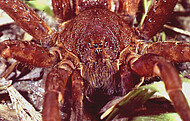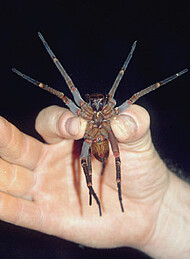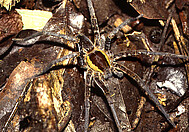Ancylometes – introduction
Spiders of the genus Ancylometes are among the largest araneomorph spiders, reaching a total body length of 4 cm and an impressive leg span of 20 cm. They live in moist tropical environments like rainforests of the Amazon or the Brazilian Atlantic forest. Specimens of the known species are abundant near ponds or small streams in these habitats or on banks of larger rivers. They can easily be found and observed with headlamps at night. At least some of the species hunt on fish, frogs and tadpoles. They might therefore be called "fishing spiders", which all live near waterbodies and show a comparable behaviour and prey spectrum (see also under Natural History).
The genus is neotropical and comprises at the moment 10 valid plus one doubtful species (A. birabeni). A generic revision with (re-)descriptions of all valid species was done by Höfer & Brescovit in Insect Systematics & Evolution (Vol. 31, 2000). The large spiders have always attracted attention and in earlier times several species were described repeatedly under different names. 23 species described under Ancylometes were synonymized and 4 species were transferred to other genera (see under Species list).
It is easy for an arachnologically experienced person to determine the belonging of specimens to the genus. Spiders present a clear ctenid eye pattern (2-4-2), but a (reduced) third tarsal claw, a character typical for pisaurids. Diagnostic for the genus is the presence of ventral spines on tarsi of the third and fourth leg. Genitalia are quite characteristic: a filiform embolus, wing-shaped conductor and hammer-like median apophysis in males; a bike-saddle like central plate, flanked by broad lateral plates of the female epigyne.
Identification to species, however, is not an easy task, due to the considerable variability in size and also in form and size of the genitalia. It is important to know the collection locality of the specimen to be identified.




